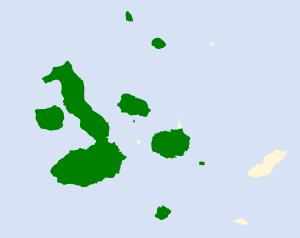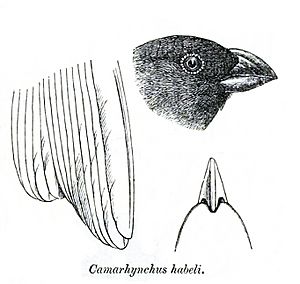Large tree finch facts for kids
Quick facts for kids Large tree finch |
|
|---|---|
 |
|
| Illustration by John Gould, 1839 | |
| Conservation status | |
| Scientific classification | |
| Genus: |
Camarhynchus
|
| Species: |
psittacula
|
 |
|
| Synonyms | |
|
Geospiza psittacula |
|
The large tree finch (Camarhynchus psittacula) is a special type of bird that lives only on the Galapagos Islands. It belongs to a famous group of birds known as Darwin's finches. These birds are part of the tanager family called Thraupidae.
Contents
About the Large Tree Finch
The large tree finch is one of the many unique birds found on the Galapagos Islands. These islands are famous for their amazing wildlife, which helped Charles Darwin develop his ideas about evolution. The large tree finch is a great example of how different species can develop over time in unique environments.
Where They Live
This finch is an endemic species, which means it naturally lives only in the Galapagos Islands and nowhere else in the world. Its favorite places to live are different kinds of forests. You can find them in dry forests, which don't get much rain, or in moist mountain forests, where it's often damp and cool.
What They Look Like
Like other Darwin's finches, the large tree finch has a beak that is well-suited for its diet. Its beak is strong and somewhat parrot-like, which helps it to eat insects and other small creatures it finds in the trees. These birds are typically small, with duller colors like brown or olive, helping them blend into their forest homes.
Why They Are Important
The large tree finch, along with other Darwin's finches, is very important for scientists. Studying these birds helps us understand how animals adapt to their environments and how new species can form. They are a living example of natural selection in action.
Protecting the Large Tree Finch
Sadly, the large tree finch is considered a vulnerable species. This means its population is decreasing, and it faces threats in its natural home. Protecting their forest habitats on the Galapagos Islands is very important to make sure these unique birds continue to thrive for future generations. Efforts are being made to conserve their homes and keep them safe from harm.
See also
 In Spanish: Pinzón de Darwin lorito para niños
In Spanish: Pinzón de Darwin lorito para niños



